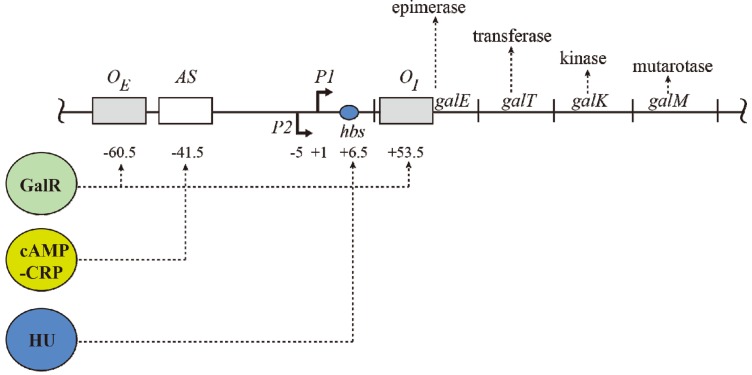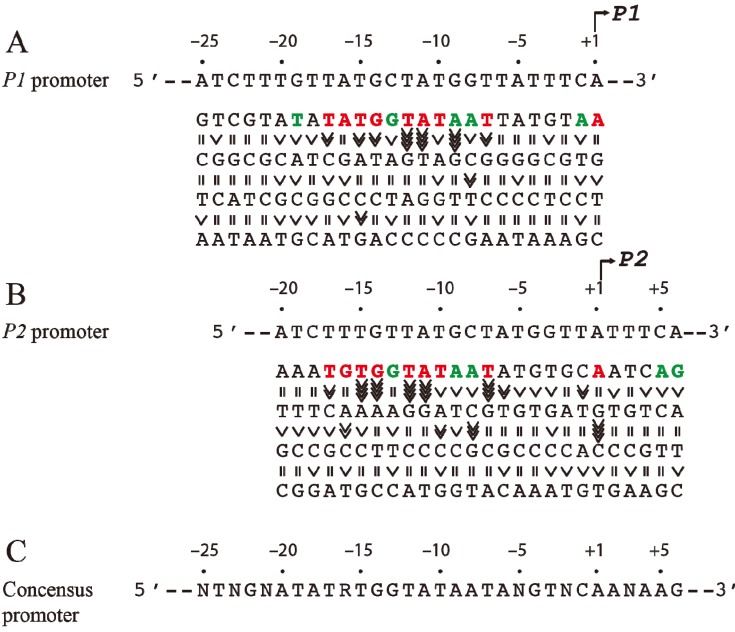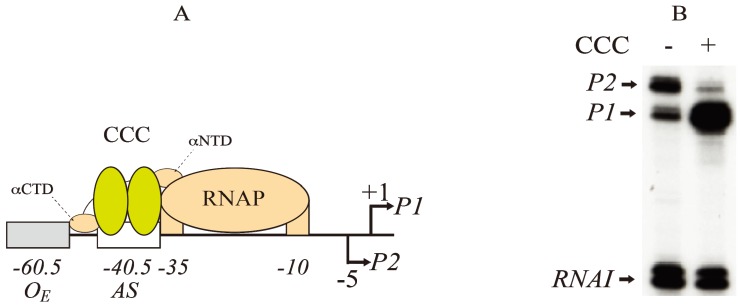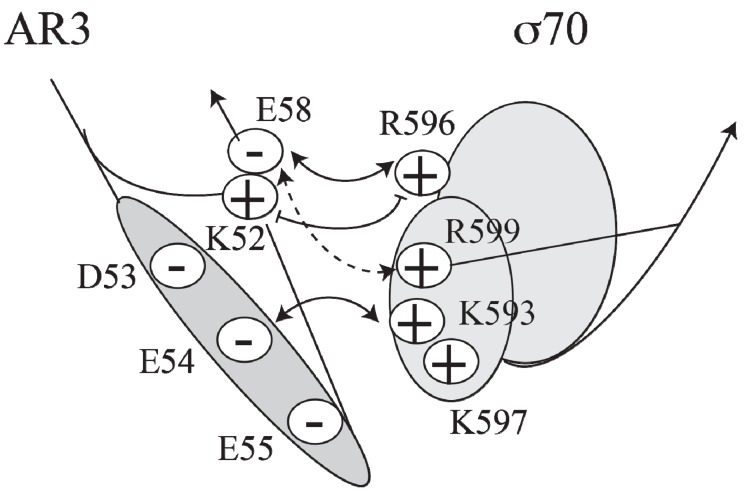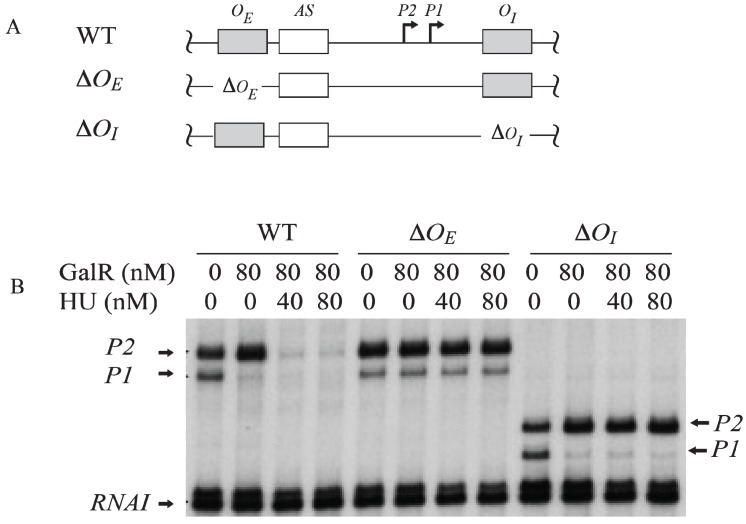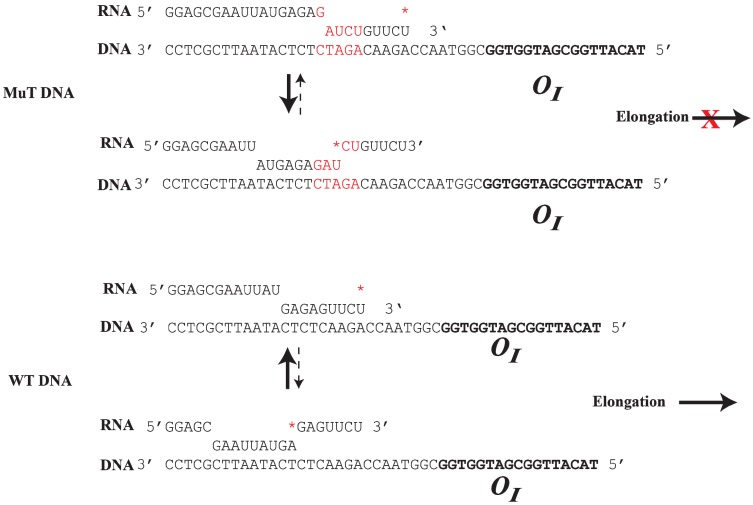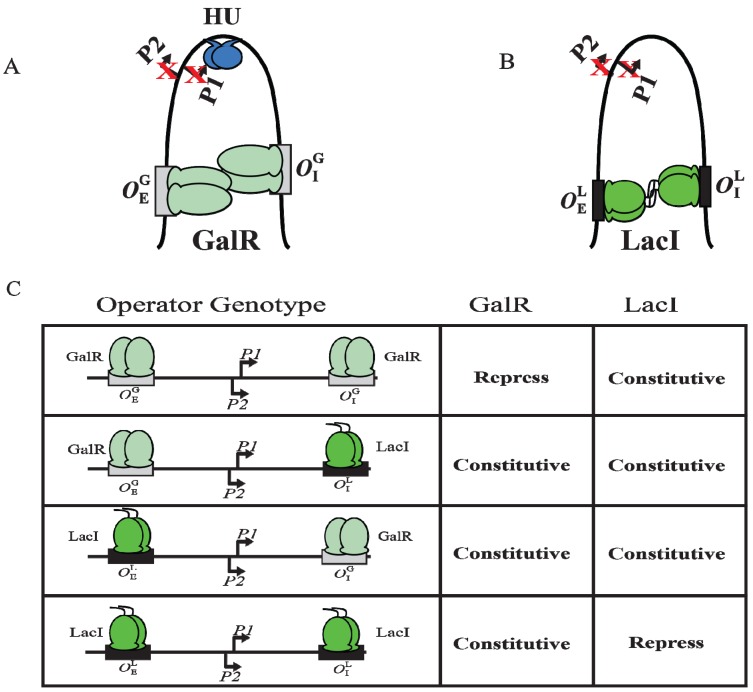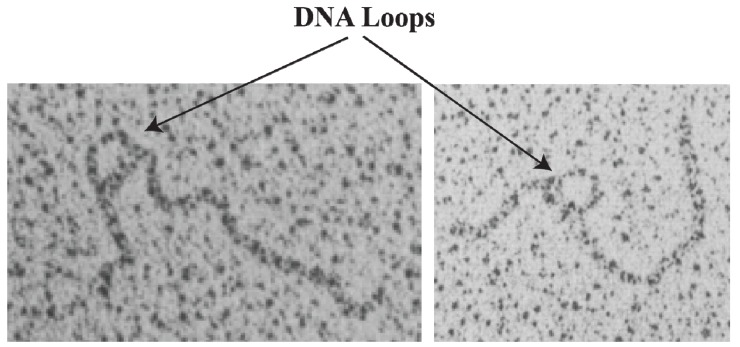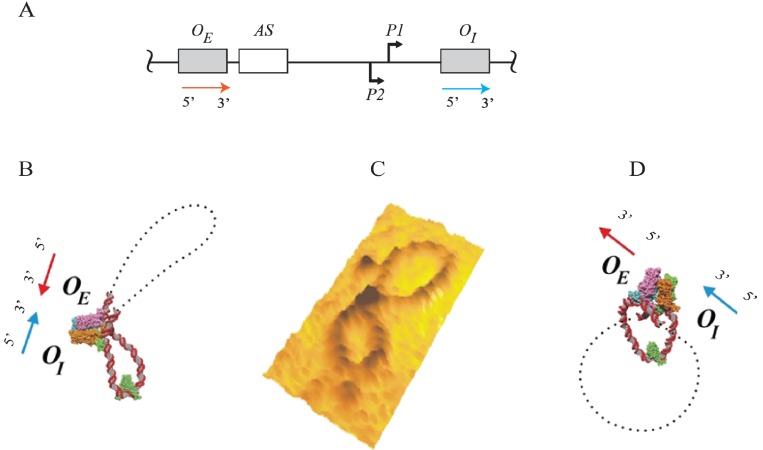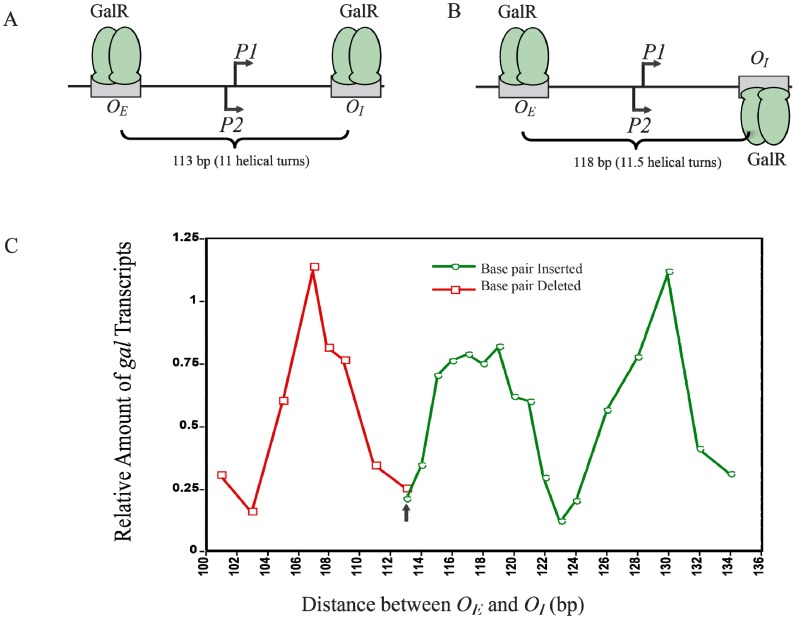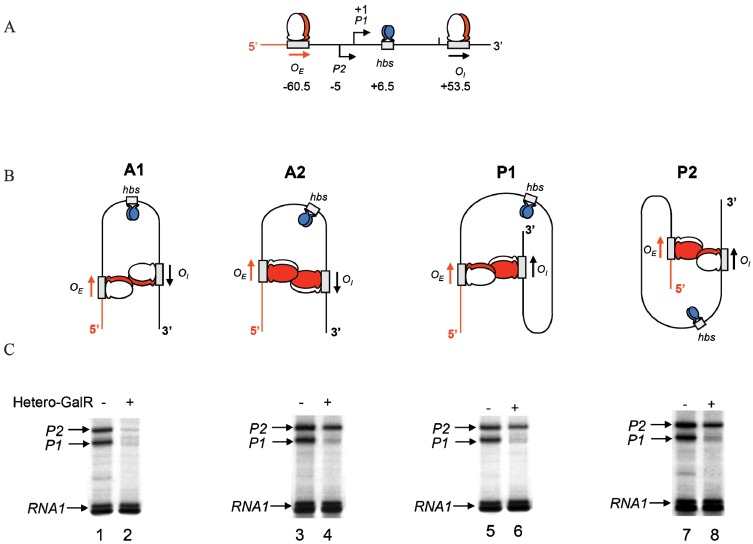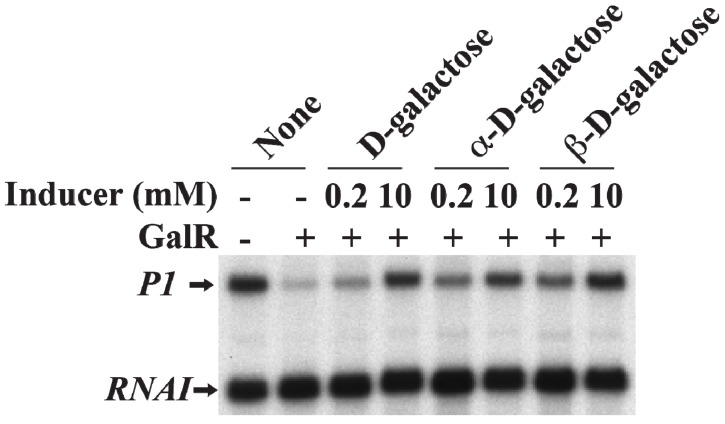Abstract
Studying the regulation of transcription of the gal operon that encodes the amphibolic pathway of d-galactose metabolism in Escherichia coli discerned a plethora of principles that operate in prokaryotic gene regulatory processes. In this chapter, we have reviewed some of the more recent findings in gal that continues to reveal unexpected but important mechanistic details. Since the operon is transcribed from two overlapping promoters, P1 and P2, regulated by common regulatory factors, each genetic or biochemical experiment allowed simultaneous discernment of two promoters. Recent studies range from genetic, biochemical through biophysical experiments providing explanations at physiological, mechanistic and single molecule levels. The salient observations highlighted here are: the axiom of determining transcription start points, discovery of a new promoter element different from the known ones that influences promoter strength, occurrence of an intrinsic DNA sequence element that overrides the transcription elongation pause created by a DNA-bound protein roadblock, first observation of a DNA loop and determination its trajectory, and piggybacking proteins and delivering to their DNA target.
Keywords: activation, repression, DNA looping, transcription, galactose operon
1. Introduction
The study of the galactose (gal) operon, which encodes enzymes for an amphibolic pathway of d-galactose metabolism, first revealed a plethora of gene regulatory mechanisms by which bacterial genes are regulated: (i) beside substrate induction of a specific catabolic pathway or end-product repression of a specific biosynthetic pathway, accumulation or depletion of metabolic intermediates in the cell globally regulates the expression of a wide variety of genes to compensate for the accumulation or depletion [1]; (ii) use of more than one promoter to regulate an operon [2]; (iii) the mechanism of Rho-mediated premature transcription termination [3]; (iv) gene regulation by a DNA element located within a structural gene [4]; (v) DNA looping to repress gene transcription [4]; (vi) the global gene activator, CRP, can also represses a gene [2]; (vii) demonstration of trajectory of DNA loops [5]; and (viii) phage protein mediated transcription anti-termination in bacterial genes [6]. Here we review more recent revelations that provide several new aspects of the multiple regulatory pathways by which gal promoters are regulated at the transcription level.
2. The Gal Operon
The gal operon is transcribed from two overlapping promoters, P1 and P2, with transcription start points marked as +1 and −5, respectively (Figure 1) [2,7,8]. Why two promoters? Each promoter responds to different regulators for coping with physiological needs as enzymes encoded in the gal operon are needed for both catabolic and anabolic metabolisms. Both promoters are intrinsically expressed at significant levels. Nonetheless, cAMP and its receptor protein CRP complex (CCC) enhances P1 but represses P2, whereas GalR represses P1 and enhances P2 (details below). CCC acts by binding to a single site AS and GalR to two operators.
Figure 1.
The gal operon. The gal structural genes, galETKM, encode the enzymes epimerase, transferase, kinase and mutarotase, respectively. The transcription start point (tsp) of P1 is +1 and that of P2 is −5 The numbering system is relative to +1, with numbers downstream of +1 as positive (+) and numbers upstream as negative (−). Operators (OE & OI), hbs: HU binding site, AS: activating site. GalR (green) binds to two operators (OE & OI). HU (blue) binds to the HU binding site (hbs) and cAMP-CRP (yellow) complex binds to the activating site (AS). The map is not drawn to scale.
3. Intrinsic Strength of Promoters
Since the tsps for P1 and P2 are separated by 5-bp (half of a helical turn on B-DNA), the two promoters are located on opposite faces of the DNA. The intrinsic strength of each promoter depends on the contribution of several critical base pairs in the promoter region [9]. Both P1 and P2 do not have functional −35 elements but are composed of ex-10 and −10 sequences as authenticated by mutational studies [10,11]. In the absence of regulatory protein, P2 is transcribed 3-fold more efficiently than P1 [12]. The intrinsic strength of a promoter was postulated to be dependent on the presence of and the closeness of DNA sequences of the different elements to their consensus forms so that the frequency of occurrence of a base pair at a given position of the element reflects its relative importance in promoter function [13]. But, the significance of the base pair frequency concept in promoter strength was developed without regard to the context sequence. It is probable that the contribution of a base pair to the promoter strength may depend upon the presence of a specific base pair at another seemingly unrelated position in the promoter. This would not be known by looking for consensus sequences among heterologous promoters. A meaningful approach would be to assess the contribution of a base pair at a given position in the promoter under the context sequence that was kept constant. To study the effects of individual base pairs on the intrinsic strength of the promoters, each base pair in the overlapping gal promoter region (from −20 to the +5) was mutated systematically to the other three base pairs and the promoter activities were analyzed by an in vitro transcription assay [14]. First, it was observed that purines at the non-template strand at the tsp of P1 and P2 are favorable for the initiation of transcription while pyrimidines are unfavorable with a preference for A = G >> C = T at the tsp (Figure 2). The tsp is determined by counting 12 base pairs from the “master base” −11A (see below) located within the −10 element of P1 and P2 [15,16]. Next, base pairs −7T, −11A, and −12T were found to be critical determinants of promoter activity. Mutating the corresponding −7T, −11A or −12T to another base inactivated P1 and P2 [14]. In addition, base pairs in the ex-10 elements (−15T and −14G) of P1 and P2 were also critical for promoter activities as expected from previous results. In summary, the base pair frequency within known consensus elements correlated well with promoter strength. Surprisingly however, P1 and P2 promoter strengths increased by substitution of several native base pairs by some others located in the −20 to −16 segment, i.e., outside the ex-10 and −10 standard elements of both promoters with a consensus sequence of −20ATATA/G−16 for the region; no sequence requirement in that segment was predicted before. How this new sequence element influences promoters is unknown. The results of the exhaustive mutational analysis about DNA sequence requirements in gal promoters are summarized in Figure 2 [14].
Figure 2.
Base pair requirement in gal promoters. (A) The DNA sequence from −25 to +1 of P1 and a summary of the effect of base pair changes from +1 to −25 on P1 transcription; (B) The DNA sequence from −20 to +6 of P2 and a summary of the effect of base pair changes from −20 to +6 on P2 transcription; (C) Consensus promoter region of P1 and P2 derived from the results shown in (A) and (B). R = A or G, N = any nucleotide. Base pair is in red if it is unique for promoter function, green if it improves promoter function, and black if it is degenerate. The symbol “>>>>” in vertical shapes represents 4.1-fold or more difference in promoter function from the wild type; “>>>”, 3.1 to 4-fold; “>>”, 2 to 3-fold; “>” less than 2-fold; “=” indicates equal (reproduced with permission from Elsevier, [14]).
The steps of closed and open complex formation in gal promoters were studied by the indirect abortive initiation method [17]. The mechanism of base pair opening during transcription initiation by RNA polymerase at the galP1 promoter was directly assayed by 2-aminopurine (2,AP) fluorescence [18]. The fluorescence of 2,AP is quenched when present in DNA duplex and enhanced when the 2,AP:T base pair is distorted or deformed. The increase of 2,AP fluorescence was used to monitor base pair distortion at several individual positions in the promoter. Base pair distortions during isomerization were observed at every position tested except at −11 in which the substitution created a defective promoter. The isomerization appeared to be a multi-step process. Three distinct hitherto unresolved steps in kinetic terms were observed, where significant fluorescence change occurred: a fast step with a half-life of around 1 s, which is followed by two slower steps occurring with a half-life in the range of minutes at 25 °C. Contrary to commonly held expectations, base pairs at different positions opened by 2,AP assays without any obvious pattern, suggesting that base pair opening is an asynchronous multi-step process. Note that 2,AP was used only at positions where there was an A in the “opening” region of the promoter.
The −11A within the −10 box is termed the “master control switch” because DNA melting and DNA strand opening first occur at −11 during isomerization from the closed to the open complex followed by opening at subsequent positions (−11 to +3) [15,19,20]. A mutant −11A does not allow base pairs at other positions to open whereas the reverse is not the case. Crystal structure studies showed that −7T and 11A flip out into hydrophobic pockets in an open complex [21,22]. This explains why any mutation in −7 and −11 positions results in the loss of gal promoter activities [14,15,19]. It also explains why −7T and −11A bases are highly conserved in the −10 element of promoters and play important roles during the formation of the open complex. It has been proposed that during isomerization, strand opening occurs from −11 to +3 to form a single-stranded DNA bubble, while −12T remains as part of the upstream double-stranded DNA bound to RNAP [14].
4. Role of CCC
The gal operon includes a 16-bp activating site (AS) located at −40.5 that binds the regulator CCC for activating P1 and repressing P2 (Figure 3A) [8,23,24,25]. A typical result of CCC action at the gal promoters is shown in Figure 3B. The overlapping of the AS at −40.5 with the −35 element of P1 is a feature of CCC-regulated Class II promoters. In contrast, in Class I promoters, the AS is located upstream (−61.5) to the promoter region for RNA polymerase (RNAP).
Figure 3.
Regulation of gal promoters by CRP complex (CCC). (A) Model of interactions between CCC (yellow) at the activating site (−40.5) and RNAP (brown) at the −10 and −35 elements of P1 (+1). P2 is located at −5 The αNTD and αCTD of RNAP contact both subunits of Class II promoters at CCC as shown in Figure 4 (adapted from [25]); (B) RNAs made typically from P1 and P2 promoters in the absence (−) and presence (+) of CCC as analyzed by gel electrophoresis. The concentrations of cAMP and CRP are 100 μM and 50 nM, respectively. RNAI is a control RNA in the plasmid (reproduced with permission from Elsevier [14]).
CCC represses P2 by decreasing open complex formation of RNAP. In contrast, CCC activates P1 by increasing both closed complex formation and isomerization from the closed complex to the open complex of RNAP [17]. The AS of CCC is located on the same face as RNAP at P1 and on the opposite face of RNAP at P2. By binding to AS, CCC switches transcription initiation from P2 to P1. The activation of P1 by CCC is also dependent on the superhelical density of the DNA. The maximal P1 activity (12-fold) was observed at a superhelical density of −0.051, but the activity decreases at both higher and lower densities on a plasmid of 3528 bp [26]. In the absence of CCC, P2 activity is maximal (2-fold) also at a superhelical density of −0.051.
5. CCC and RNAP Interactions
Cooperative binding between CCC and RNAP was demonstrated using DNase I protection assays [28]. Amino acids involved in the interaction of CCC with RNAP that produced cooperative binding are confined to three activating regions (AR1, AR2 and AR3) of CRP [29,30,31,32,33,34,35,36,37]. The alpha carboxyl-terminal domain (αCTD, residues 249–329) of RNAP interacts with CRP at AR1 (residues 156–164), the alpha amino-terminal domain (αNTD, residues 8–235) interacts with CRP at AR2 (residues 1, 9, 21, 96 and 101), and the σ70 subunit of RNAP interacts with CRP at AR3 (residues 52–58) [25,29,34,38]. The crystal structure of CCC-αCTD-DNA complex has been determined [36].
CCC induces transcription at P1, a Class II promoter, by making three different activatory contacts with different surfaces of holo RNA polymerase [34]. One of the contacts is located in the downstream subunit of the CRP dimer at the AS site and has been predicted to interact with region 4 of the RNAP σ70 subunit [27,39]. A cluster of negatively charged residues (D53, E54, E55 and E58) in AR3 of CRP interacts with a cluster of positively charged residues (K593, K597, R599 and R596) in σ70 (Figure 4).
Figure 4.
Model of the interactions between AR3 and sigma 70 (adapted from [27]).
RNAP predominantly forms a binary complex at the P2 promoter in the absence of CCC and a ternary complex at the P1 promoter in the presence of CCC. Very high concentrations of heparin are able to dissociate CRP from the P1 ternary complex without changing the properties of the complex. Thus, CCC is not required for the maintenance of the RNAP complex and plays no role in the subsequent steps in P1 transcription as was true for several other promoters [40], suggesting that interaction between CCC and RNAP is needed only transiently for the activation of transcription.
6. CCC Action on Templates with Single bp Deletions
The role of individual base pairs from −49 to +1 on CCC action was investigated by systematically deleting each base pair and monitoring the effect of CCC on P1 activation and P2 repression (Figure 5A). Deletion of one base pair from positions +1A to −10T (Δ+1A to Δ−10T) does not affect the activation of P1 or the repression of P2 by CCC (Figure 5B). The deletion of 1-bp shifted the next adenine from +3 in WT to +2 in the deletion templates (Δ+1A to Δ−10T), allowing the tsp of P1 to initiate at the new +2A [16]. P2 with tsp of −5A was inactivated with single bp deletion from Δ−5A to Δ−8/9G, because, no adenine or guanine is available from −4 to −2 to initiate P2. Single bp deletion of −11A or −12T inactivated both promoters. Interestingly, the tsp of P1 initiated at the new +2A on Δ−11A as observed by the faint transcript band in the presence of CCC. In Δ−12T, P1 initiates at the WT +1A, suggesting that if the distance from −11T to +1 (12-nt) is shortened, RNAP will choose the next downstream purine to initiate transcription.
Figure 5.
Effect of base pair deletions on in vitro transcription of gal promoters. (A) Sequence of gal DNA from −68 to +6 with tsp of P2 (−5) and P1 (+1). The −10 element of P1 and −10 element of P2 are boxed. The CCC site (AS) is also boxed; (B) mRNAs made from P1 and P2 from WT and mutant templates (Δ−1 to Δ−15) (reproduced with permission from John Wiley and Sons); (C) mRNAs made from P1 and P2 from WT and mutant templates (Δ−16 to Δ−33); (D) mRNAs made from P1 and P2 from templates with WT and mutant templates (Δ−34 to Δ−49).
The −12T position is the first base of the −10 element of P1 and the last base of the −10 element of P2. It is not surprising that the intrinsic transcription of both P1 and P2 was inactivated, and CCC failed to activate P1. The −13C to −17T sequence contains the ex-10 of P1 (−15TG−14) and the −10 element of P2 (−17TATGCT−12). Sigma region 2.5 of RNAP recognizes the ex-10 motif of promoters [41,42,43,44]. Detailed analyses of the ex-10 showed the importance of the ex-10 element in transcription regulation [43]. Deletions of −16A and −17T/−18T result in approximately 5- and 2-fold activation of P1 by CCC, respectively (Figure 5C). P2 was inactivated from −5A to −19G because its tsp, ex-10 and −10 elements (−20TGTTATGCT−12) are altered. From −20T to −33C, the regulation of P1 and P2 is restored.
CCC is known to protect the AS region in the gal DNA from −50 to −25 bp by DNase I protection assays [10,31,45,46,47]. AS contained a non-consensus (NC) half-site and a consensus (C) half-site separated by a 6-bp spacer [48,49,50,51]. The AS extends from −49 to −34. Thirteen mutations each of which inhibits CCC action are located in the consensus half-site from −38 to −34 () proximal to the promoters [23,52]. When −34A is deleted, there is only marginal activation of P1 and repression of P2 (Figure 5D). There was no noticeable change in P1 or P2 levels in the absence or presence of CCC when a base pair in the consensus half-site is deleted. These results suggest that CCC fails to bind to AS when a base pair is deleted in the consensus half-site. The basal level of P2 was increased by 2-fold in Δ−38T. Perhaps a stronger −35 element of P2 is created with Δ−38T. The activation of P1 by CCC was restored with single base pair deletions upstream of the consensus half-site from Δ−39G to Δ−47/48/49T. P1 was activated only 4-fold in Δ−39G. These results suggest that the 6-bp spacer between the consensus and non-consensus half-sites do not affect CCC binding. These also suggest that mutations of the non-consensus half-site do not affect the activation of P1 by CCC. Interestingly, Δ−41A and Δ−46A are the only two mutations in P1, which were activated 9-fold in Δ−41A and 8-fold in Δ−46A by CCC. However, in both Δ−41A and Δ−46A templates, CCC activated P2 marginally. Busby and colleagues showed that the consensus half-site is inactivated by three substitution mutations, p35 (−35 CG to GC), p37 (−37CG to AT) and p38 (−38 TA to AT) [23,52]. They also showed that AS, unlike in WT, is not protected by CCC in p35, p37 and p38 mutants [10,46]. EMSA shows no stable complexes of CCC binding to a 144-bp DNA fragment containing p35, p37, or p38 mutations [46].
In summary, (i) the distance between −11 and +1 determines the start point selection of P1 and P2. If a purine is not available at +1, RNAP selects the next downstream purine within 12–13 bp from −11A; (ii) the −7T, −11A and −12T are critical bases of the −10 elements of P1 and P2 for promoter function. Any deletion or substitution of these bases prevents intrinsic transcription. CCC restores transcription from P1 in −7T and −12T, but not in −11A; (iii) both base pairs in the ex-10 elements (−15TG−14) are critical in both P1 and P2 because deleting or substituting one of them inactivates both promoters; (iv) any base pair deletion in the spacer region from −20 to −33 does not affect the activation and repression of P1 and P2 by CCC, respectively; (v) CCC fails to activate P1 or repress P2 when any base pair in the consensus half-site (−34 to −38) of AS is deleted; (vi) any base pair deletion except −41 and −46A in the non-consensus half-sites does not affect the regulation of the promoters by CCC. The conclusion from the results of single base pair deletions about the role of base pairs in the promoters are mostly the same as from the results of single base pair substitutions in the gal promoters.
7. Regulation by GalR-OE Complex
To investigate the role of each operator in contact inhibition of P1, and contact activation of P2, OE or OI was subjected to mutational analysis (Figure 6A). The result shows that the GalR-OE complex formation is sufficient for the repression of P1 (Figure 6B) [53,54,55,56]. When OE was deleted, there was no inhibition of P1, no activation of P2. When OI was deleted, GalR-OE complex still repressed P1 and activated P2. When OI was deleted, the length of the transcripts from P1 and P2 was reduced by 16-nt since OI is located downstream of both promoters. There is no change in the length of the transcripts from P1 and P2 when OE was deleted because the tsps of the promoters are located downstream of the OE.
Figure 6.
Role of the operators in the transcription regulation of gal promoters. (A) Templates showing ΔOE and ΔOI deletions; (B) mRNAs made from P1 and P2 on OE and OI, ΔOE and OI, and OE and ΔOI templates in the presence of GalR (80 nM) and HU (40 nM, 80 nM) (adapted from [54]).
The operon consists of two GalR binding sites (16-bp operators), OE (external operator, located at position −60.5) and OI (internal operator within galE, located at +53.5) [2,4,57]. The galE gene starts at an ATG (methionine code) located at position starting at +27. The operators are located 113-bp (~11 DNA helical turns) from each other (center to center distance) (Figure 1). GalR binds to each operator as a dimer.
The binding of GalR to OE represses P1 and activates P2 (Figure 6B and Figure 7A). GalR bound to OE is located on the same DNA face as RNAP bound to P1 (Figure 7A), but on the opposite DNA face as RNAP bound to P2 (Figure 7B). GalR represses P1 by inhibiting the rate determining open complex formation through RNAP contacts [58]. This mode of repression is termed “contact inhibition” (Figure 7A). While P1 is repressed by GalR-OE complex, P2 is activated by GalR-OE complex by a direct contact between GalR and RNAP, “contact activation” (Figure 6B and Figure 7B). GalR-OE enhances open complex formation at P2 presumably in the same way CCC does in P1 [12,53,59]. In P1, GalR energetically traps RNAP at an intermediary complex [53]. GalR mutants (nc, for negative control) that bind to OE and do not repress P1 but represses P2 have been isolated. These mutations presumably define the contact points of GalR to which RNA polymerase binds while occupying P1 and need to be characterized further [60]. The contact points of RNAP for GalR are unknown.
Figure 7.
Models of GalR-RNAP contacts. (A) Contact inhibition of P1: GalR (light green) at OE is interacting with the α-CTD of RNAP (brown) at the −10 and −35 elements of P1; (B) Contact activation of P2 with the α-CTD of RNAP at the −10 and −35 elements of P2.
8. Roadblock of RNAP by GalR-OI Complex
The OI operator is located at position +53.5, which is in the path of elongating RNAP complex transcribing from P1 and P2. The question is whether GalR-OI complex can inhibit or block RNAP elongation [61]. Unexpectedly, transcription from the gal promoters under in vitro conditions overrides the expected physical block created by the presence of the GalR bound to OI (Figure 8). It has been shown that although a stretch of pyrimidine residues (UUCU) in the RNA/DNA hybrid located immediately upstream of OI weakens the RNA/DNA hybrid and favors RNA polymerase pausing and backtracking after encountering the roadblock, a stretch of purines (GAGAG) in the RNA present immediately upstream of the pause sequence in the hybrid acts as an anti-pause element by stabilizing the RNA/DNA duplex and preventing further backtracking. This facilitates forward translocation of RNAP, including overriding of the DNA-bound GalR barrier at OI [61]. Consequently, when the GAGAG sequence is separated from the pyrimidine sequence by a 5-bp DNA insertion, RNAP backtracking is favored from a weak hybrid to a more stable hybrid (Figure 8). The roadblock of RNAP by GalR-OI complex in the template with the 5-bp insertion was rescued by the transcription elongation factor, GreB, but not GreA. GreB and GreA cleave backtracked RNA in the catalytic center of RNAP to create a new 3'-end of the RNA, which can then be elongated [62,63,64,65]. As expected, the roadblock is also rescued by d-galactose, which dissembles the GalR-OI complex, allowing RNAP to continue transcription [61]. The ability of a native DNA sequence to override roadblocks in transcription elongation in the gal operon uncovers a previously unknown way of regulating transcription.
Figure 8.
Role of DNA sequence in RNAP elongation or backtracking. (Top): The mutant DNA contains an insertion of 5-bp (GATCT, red color), which creates a weak RNA:DNA hybrid at the 3' end of the RNA. RNAP prefers to backtrack to a more stable RNA:DNA hybrid from a weak hydrid, preventing elongation; (Bottom): In WTDNA, a strong 9-bp RNA:DNA hybrid is formed at the gal pause site upstream from OI. RNAP prefers to elongate instead of backtracking by 7-bp to a weak RNA:DNA hybrid. The * indicates the 3' end of the RNA (reproduced with permission from Elsevier [61]).
9. DNA Looping
Although GalR binding to a specific operator (OE or OI) has different regulatory outcomes, simultaneous binding of GalR to both operators (in the presence of HU; see later) represses both P1 and P2 (Figure 6B). It was proposed that GalR bound to the distally located operators interact with each other forming a loop of the intervening DNA that contains the promoters (Figure 9A). To test this model, a set of bipartite operators was constructed by converting gal operators to lac operators in various combinations (, , , ) and gal repression was studied in vivo [66]. GalR and LacI are part of the GalR-LacI family, in which members show 60% homology in sequence [67]. Simultaneous repression of both promoters occurred only with homologous operators ( or ) in the presence of the cognate repressor (Figure 9A–C) [66]. GalR does not recognize lac operators and LacI does not recognize gal operators. These results suggest that the occupation of both operators by heterologous proteins was not sufficient for complete repression of the promoters. It was also inferred that protein-protein interactions occur between homologous proteins bound to cognate operators to form DNA loop and being about repression.
Figure 9.
DNA looping by GalR and LacI. (A) Repressome formation by GalR-OE and GalR-OI interactions with HU (blue) and supercoiled DNA. DNA looping repressed both P1 and P2; (B) DNA looping by LacI binding to lac operators; (C) The in vivo level of galactokinase, a product of the gal operon is reported as repressed or constitutive in the presence of GalR and LacI on , , and templates. GalR is in light green and LacI is in dark green. The gal operators are in grey rectangular boxes, while the lac operators are in black rectangular boxes (adapted from [66]).
10. Mechanism of Repression by DNA Looping
Although an interaction between GalR-OE and GalR-OI complexes to generate a DNA loop was predicted from the in vivo results, in vitro experiments could not demonstrate DNA looping in gal DNA in the presence of GalR [68]. In vitro, DNA looping additionally needs the presence of the histone-like protein HU and supercoiled DNA (see below). HU assists the GalR-OE complex and the GalR-OI complex in stabilizing a higher-order complex structure, resulting in a DNA loop (see below). The histone binding site (hbs) is located in the apex of the loop where the DNA is bent by HU binding, forming the higher-order structure and repressing both P2 and P1 (Figure 6B) [68]. The higher-order structure is termed “repressosome” (Figure 9A). P2 is repressed only by the repressosome. Incidentally, repression of both P1 and P2 at the same time by GalR-HU mediated DNA looping overrides the GalR-OE and CCC-AS mediated DNA looping differential regulation of P1 and P2. Mechanistically, synergistic binding of GalR to distal sites forms 113 bp DNA loop which is a topologically closed domain containing the two promoters [56]. A closed DNA loop of 11 helical turns, which is in-flexible to torsional changes, disables the promoters either by resisting DNA unwinding needed for open complex formation or by impeding the processive DNA contacts by an RNA polymerase in flux during transcription initiation. Interaction between two proteins bound to different sites on DNA modulating the activity of the intervening segment toward other proteins by allostery may be a common mechanism of regulation in DNA-multiprotein complexes.
As mentioned the P1 promoter of gal contains only ex-10 and −10 DNA elements and no −35 element. Thus, recognition of P1 does not require specific contacts between RNA polymerase and its −35 element region. To investigate whether specific recognition of the −35 element would affect the regulation of P1 by GalR, variants of P1 in which the −35 element was restored were constructed and their regulation by DNA looping were studied by in vitro transcription assays [69]. The results showed that the GalR-mediated DNA loop is less efficient in repressing P1 transcription when RNA polymerase binds to the −10 and −35 elements concomitantly. The most likely explanation of RNA polymerase binding to −35 element inhibiting DNA looping is that RNA polymerase binding to −35 element is known to create a bend in the DNA at an improper position inhibits DNA loop formation.
11. In Vitro Evidence of DNA Looping
DNA looping of LacI binding to two operators () is supported by direct visualization using of electron micrographs (EM), showing a loop size of 95-bp with two arms in long linear DNA (Figure 10) [70]. A dimeric LacI mutant that is unable to form tetramers failed to form DNA loops. GalR-HU-DNA mediated repressosome (DNA loop) was visualized by atomic force microscopy (AFM) on DNA minicircles of 688-bp with a figure-of-eight structure containing two loops: a 113-bp loop and a large loop of 555-bp as expected [71]. However, the geometry of the loop (antiparallel or parallel) is not distinguishable by this AFM image because of the positions of the two operators in the 688-bp plasmid. To address the geometry of the loop, minicircles of 599-bp containing an additional 84-bp insertion between OE and OI is used to show a small loop size of 197-bp and a larger loop of 402-bp with GalR and HU (Figure 11) [72]. The geometry of the DNA loop (Figure 11C) is antiparallel (Figure 11B) and not parallel (Figure 11D). AFM study with LacI and lac operators containing the same size DNA (lac operators replaced the gal operators) also reveals an antiparallel loop [72].
Figure 10.
Electron micrograph of LacI-mediated DNA loop. The arrow points to the DNA loop of 95 bp in the () DNA. One end of the DNA is 130 bp from the loop and the other end is 380 bp (reproduced with permission from Cold Spring Harbor Laboratory Press [70]).
Figure 11.
Atomic force microscopy of GalR-HU mediated DNA loops. (A) Sketch of the gal DNA with a red arrow in the direction of 5' to 3' for OE and with a blue arrow in the direction of 5' to 3' for OI; (B) Model of antiparallel loop with the 3' of OE and OI facing each other in a head-to-head arrangement; (C) AFM results showing an antiparallel loop as predicted in model (B); (D) Model of parallel loop with the 3' of OE and OI facing opposite direction in a tail-to-head arrangement (reproduced with permission from Elsevier [72]).
12. Helical Arrangement of Operators
The centers of the operators OE and OI are separated by 11 DNA helical turns, thus making the location of two operator-bound GalR on the same face of DNA. This arrangement energetically allows an interaction between two DNA bound GalR dimers, and consequent DNA looping and transcription repression, (Figure 12A). To investigate the dependence of transcription repression on the relative helical turns of the location of OE and OI, the helical arrangement of OE and OI was changed by either deleting 2- to 12-bp within positions −50 to −38 to decrease the number of helical turns or by inserting 1- to 21-bp between positions +32 and +33 to increase the helical turns [73]. Figure 12C shows that the optimal repression of gal RNA synthesis is achieved at a net distance of 103-, 113-, 123-, and 133-bp, corresponding to 10, 11, 12 and 13 full helical turns, respectively. However, when a 5-bp segment was deleted (108-bp distance) or 5- and 15-bp segments were inserted (118- and 128-bp distance respectively), gal repression was lifted as judged by the high expression of RNAs even in the presence of GalR, HU and supercoiled DNA presumably making the GalR-OE and GalR-OI complexes now located on the opposite face of the DNA more difficult to make GalR-GalR contact for DNA looping (Figure 12B). Moreover, the loop size between OE and OI can be increased up to a total of 19 helical turns to maintain loping-mediated repression [72]. Above 19 helical turns, the repression was reduced, perhaps because a bound RNAP is able to overcome DNA torsional stress and form open complex.
Figure 12.
Looping-mediated repression of gal transcription is dependent on the helical distance between operators. (A) GalR-OE and GalR-OI are located on the same face of the DNA at a distance of 113-bp (11 helical turns); (B) GalR-OE and GalR-OI are located on the opposite face of DNA at a distance of 118-bp; (C) Relative amount of transcription vs. distance between the two operators in base pair in the presence of GalR and HU. The results of deleted base pairs (12 bp) are in red and the results of inserted base pairs are in green. The arrow indicates the WT distance between operators (adapted from [73]).
13. Role of HU in DNA Looping
HU is a small basic protein consisting of a heterodimer of α and β subunits, and binds to a 9-bp DNA [74,75]. The hupA gene codes for Huα (~9 kDa) and the hupB gene codes for Huβ (~9 kDa) [76,77]. The involvement of HU in DNA looping and the repression of the gal operon were investigated in vivo by monitoring the activity of β-glucuronidase from gusA fused to the P2 promoter. The hupA and hupB genes were deleted (ΔhupA::cmR and ΔhupB::kmR) to generate hupA+B−, hupA−B+, and hupA−B− strains [78]. In wild-type strain (hupA+B+), the β-glucuronidase activity of P2 was repressed when both genes are present (Figure 13A). In the presence of the hupA gene (hupA+B−), P2 is strongly repressed as in wild-type cells, suggesting that hupA is sufficient to achieve complete repression of P2 by DNA looping. When hupA is inactivated (hupA−B+), the repression of P2 is slightly weaker than that for hupA+B+ and hupA+B−. The derepression of β-glucuronidase activity of P2 was completely constitutive only in the hupA−B− strain. The P2 activity of hupA−B− is comparable to that of P2 activity in the presence of d-galactose, an inducer of the gal operon (Figure 13B) [78].
Figure 13.
Effect of HU and d-galactose on P2 in vivo. (A) β-glucuronidase activity as a reporter of the P2 promoter in WT (hupA+B+) and mutants (hupA+B−, hupA−B+ and hupA−B−) strains; (B) β-glucuronidase activity from P2 in WT (hupA+B+) strain in the absence and presence of d-galactose; (C) β-glucuronidase activity from P2 in WT (hupA+B+) strain in the presence of various coumermycin concentrations. The arrow indicates where d-galactose or coumermycin was added. In each panel, the x-axis shows cell OD (reproduced with permission from John Wiley and Sons Ltd. (Hoboken, NJ, USA) [78]).
14. DNA Supercoiling
DNA loping by GalR and HU occurs only with supercoiled DNA as was observed by in vitro transcription of P2. P2 repression was totally dependent upon with supercoiled DNA template [78]. Moreover DNA looping mediated repression in vivo requires supercoiled chromosome [71]. Coumermycin, a DNA gyrase inhibitor, also derepressed the P2 promoter as expected when it was added to cells in the absence of d-galactose (Figure 13C).
15. Piggybacking HU
GalR mediated DNA looping requires binding of HU to an architecturally critical position on DNA (hbs) to facilitate the GalR-GalR interaction. It has been shown that GalR piggybacks HU to the critical position on the DNA through a specific GalR-HU interaction [79]. The thermodynamic parameters of some of the required interactions, GalR-OE, GalR-GalR, HU-GalR, and HU-GalR-OE, were studied by analytical ultracentrifugation, fluorescence anisotropy, and fluorescence resonance energy transfer [80]. The physiological significance of several of these interactions was confirmed by the finding that a mutant HU, which is unable to help looping in vivo and in vitro, failed to show the HU-GalR interaction. The results helped to construct a pathway of DNA looping (Figure 14). Structure-based genetic analysis indicated that the two DNA-bound GalR dimers interact directly and form a stacked tetramer in assembling a transient loop [81]. The loop is stabilized by HU leaving GalR and binding to the architecturally critical position on the DNA. The GalR-HU contact is likely transient and absent in the final loop structure. A sequence-independent DNA-binding protein being recruited to an architectural site on DNA through a specific association with a regulatory protein may be a common mode for assembly of complex nucleoprotein structures [80].
Figure 14.
Pathway of Repressosome formation. GalR (light green) and HU (blue) first bind together, then bind to the DNA, resulting in DNA loop formation with HU dissociating from GalR and binding to the apex of the DNA stabilizing the loop involving GalR-GalR interactions (adapted from [80]).
16. DNA Loop Trajectory
In the scheme of DNA looping as shown in Figure 14, the alignment of the operators in the DNA loop could be in either parallel (P) or antiparallel (A) mode (Figure 15). Feasibilities of these trajectories were tested by in vitro transcription repression assays, first by isolating GalR mutants with altered operator specificity and then by constructing proper operator sequences to allow formation of mutant GalR heterodimers bound to specific hybrid operators in such a way as to give rise to only one of the two putative trajectories (parallel (P) or antiparallel (A)) [5]. A1 loop is formed when the 3'-end of OE is facing the 3'-end of OI in a head-to-head (→ ←) orientation. The A2 loop is formed when the 3'-end of OE is facing away from the 3'-end of OI in a tail-to-tail (← →) orientation. In P1, the 3'-end of OE is located in the same direction as the 3'-end of OI in a head-to-tail (← ←) configuration, while in P2, the 3'-end of OE is located in the opposite direction as the 3'-end of OI in a tail-to-head (→ →) configuration. Results show that OE and OI adopt a mutual antiparallel orientation in an under-twisted DNA loop, consistent with the energetically optimal structural model. In this structure the center of the HU-binding site is located at the apex of the DNA loop (Figure 15).
Figure 15.
Trajectory of DNA loops formed by GalR and HU; (A) The gal regulatory region containing promoters (P1 and P2), operators (OE and OI), HU binding site (hbs). The arrows at OE and OI are shown in the direction 5' to 3'; (B) Two trajectories of DNA loops, “antiparallel” (A), and “parallel” (P); (C) mRNAs made from P1 and P2 in antiparallel or parallel configurations (reproduced with permission from Cold Spring Harbor Laboratory Press, [5]).
17. Single Molecule Evidence of DNA Looping
Single DNA molecule experiment was first used to demonstrate looping in the lac operon with a linear DNA [82]. The same principle was employed to demonstrate DNA looping in gal in which the extra factor HU and supercoiling of the DNA were needed [83]. Single DNA molecules each containing two operator sequences 113 bp apart, with one end tethered to a magnetic bead and the other to a surface can be twisted to mimic DNA superhelicity by using small magnets placed above the sample and the end-to-end distance measured. Under such conditions DNA loop formation by GalR and HU reduced the bead-to-surface distance by an expected amount. GalR/HU-mediated DNA looping was directly detected and characterized for its kinetics, thermodynamics, and supercoiling dependence. Transitions in DNA length between unlooped state and looped state were observed in the presence of GalR and HU (Figure 16A). There was no transition in the absence of either GalR or HU. The optimal super helical density (σ) for looping was −0.03. Looping was not observed with untwisted (relaxed) DNA making negative supercoiling an essential element for looping in this system unlike loop formation in lac (Figure 16B) [82]. These experiments also confirmed that DNA looping in gal occurs with an antiparallel DNA trajectory of the two operator [84].
Figure 16.
Single molecules of DNA looping. (A) Traces of DNA in the presence of GalR, HU, d-galactose or single-stranded DNA (SSB) with DNA supercoiling (σ = −0.03) and magnetic forces of 0.88, 1.05 and 1.32 pN; (B) DNA looping vs. superhical density (σ) (reproduced with permission from the National Academy of Sciences, USA, [83]).
18. GalR-GalR Interface for DNA Looping
How does GalR-OE complex interact with GalR-OI complex to bring about tetramerization and DNA looping? This question was addressed by isolation and characterization of single amino acid galR mutants, which bind to DNA (P1 repression proficient) but does not form DNA loop (P2 repression deficient) [85]. A reporter gene of OE P1+P2−~lacZ was used to monitor P1 repression and an OE P1−P2+OI ~gusA fusion was used to screen for P2 repression. Such GalR mutants (defective in GalR-GalR interactions, and thus DNA looping but retains DNA binding to OE), R325H, D258N and E230K, were located on a surface of a model structure of GalR dimer structure. The area can act as interface between two GalR dimers [85]. In vitro studies confirmed that the interface mutants, R325H, D258N and E230K, do not repress P2 but repress P1.
19. Induction of Gal Operon by d-Galactose
d-Galactose, an inducer of GalR, acts by inactivating GalR. d-galactose binding to GalR results in an allosteric change in the protein, which cannot contact RNAP or bind to DNA anymore. This neutralizes any regulatory effect of GalR. d-galactose is a mixture of both α-anomer and β-anomer [86]. Purified α-anomer and β-anomer were used to investigate whether the α-anomer or β-anomer or both can inactivate GalR for P1 transcription from the repressed state of the promoter in vitro. The result showed that both α-anomer and β-anomer act as inducer by lifting the repression of P1 transcription without DNA looping (Figure 17).
Figure 17.
Derepression of P1 by d-galactose. mRNAs made from P1 in the presence of GalR (80 nM) and d-galactose, α-d-galactose or β-d-galactose 0.2 and 10 nM) (adapted from [86]).
How does d-galactose disrupt the repressosome structure? In case of DNA looping mediated repression of P2, the presence of d-galactose first breaks up GalR-GalR tetramers into individual operator-bound dimers in which state P1 is still largely repressed and P2 is derepressed [87]. Next, d-galactose helps to dissociate GalR from GalR-OI complex, and finally, GalR dissociates from GalR-OE complex to disassemble the remaining complex. This also confirms that GalR-OE complex is more stable than GalR-OI complex [87].
20. Conclusions
The gal operon of E. coli plays an important role in cellular metabolism by encoding enzymes that catalyze conversion of d-galactose to energy sources as well as to anabolic substrates. The operon is transcribed from two overlapping promoters, P1 and P2. The importance of individual base pairs at various positions in the −49 to +1 segment in the gal promoters for transcription and its regulation were discerned by substitutions, deletions or insertions of base pairs. First, a 12-bp distance from the master base pair (−11) is a determinant of transcription start point (+1), which is preferably a purine. Second, two of the standard RNAP recognition elements, ex-10 and −10, are responsible for determining the strength of the two gal promoters. Genetic analysis of the two overlapping promoters also identified that the DNA sequence of the segment −20 to −16, which is outside the boundaries of the previously defined promoter elements, contribute to promoter strength in both P1 and P2.
Regulatory proteins, CCC and GalR, regulate the two promoters coordinately and differentially depending on the cellular conditions. (i) CCC binds to the AS element at position −41.5 and activates P1 and represses P2 both at the step of open complex formation; (ii) GalR acts by binding to two operators, OE and OI. The GalR-OE complex inhibits P1 and stimulates P2 by contacting the αCTD of RNAP by preventing open complex formation at P1 and enhancing open complex formation at P2; (iii) Interestingly, the GalR-OI complex does not create a road-block to any elongating RNAP from P1 and P2 because of the presence of anti-pause sequence in the immediate upstream area that occludes pause; (iv) In the presence of the histone-like protein, HU, and supercoiled DNA as template, interactions of the two operator-bound GalR, results in the formation of a DNA loop (repressosome). The trajectory of DNA in the loop is antiparallel, as revealed by biochemical experiments and AFM observations. Genetic analysis of GalR identified the protein interface between GalR-OE and GalR-OI at the looped state. Looping needs the binding of HU to the apex of the looped DNA that stabilizes the repressosome complex. GalR interacts with HU and piggybacks the latter to its binding site. In the final structure, there is no GalR-HU contact. The helical arrangement between GalR-OE and GalR-OI is important for facilitating DNA looping. When they are located on the same face of the DNA looping is favorable; when not on the same face, energetics prevents DNA looping.
Acknowledgments
This work was supported by the Intramural Research Program of the National Institutes of Health, the National Cancer Institute, and the Center for Cancer Research. We thank Susan Garges, Kara Lewis and Deborah Hinton as well as the reviewers for critical and helpful comments on this chapter.
Author Contributions
Both Dale Lewis and Sankar Adhya contribute to the writing of the manuscript.
Conflicts of Interest
The authors declare no conflict of interest.
References
- 1.Lee S.J., Trostel A., Le P., Harinarayanan R., Fitzgerald P.C., Adhya S. Cellular stress created by intermediary metabolite imbalances. Proc. Natl. Acad. Sci. USA. 2009;106:19515–19520. doi: 10.1073/pnas.0910586106. [DOI] [PMC free article] [PubMed] [Google Scholar]
- 2.Adhya S., Miller W. Modulation of the two promoters of the galactose operon of Escherichia coli. Nature. 1979;279:492–494. doi: 10.1038/279492a0. [DOI] [PubMed] [Google Scholar]
- 3.De Crombrugghe B., Adhya S., Gottesman M., Pastan I. Effect of Rho on transcription of bacterial operons. Nat. New Biol. 1973;241:260–264. doi: 10.1038/newbio241260a0. [DOI] [PubMed] [Google Scholar]
- 4.Irani M.H., Orosz L., Adhya S. A control element within a structural gene: The gal operon of Escherichia coli. Cell. 1983;32:783–788. doi: 10.1016/0092-8674(83)90064-8. [DOI] [PubMed] [Google Scholar]
- 5.Semsey S., Tolstorukov M.Y., Virnik K., Zhurkin V.B., Adhya S. DNA trajectory in the Gal repressosome. Genes Dev. 2004;18:1898–1907. doi: 10.1101/gad.1209404. [DOI] [PMC free article] [PubMed] [Google Scholar]
- 6.Adhya S., Gottesman M., de Crombrugghe B. Release of polarity in Escherichia coli by gene N of phage lambda: Termination and antitermination of transcription. Proc. Natl. Acad. Sci. USA. 1974;71:2534–2538. doi: 10.1073/pnas.71.6.2534. [DOI] [PMC free article] [PubMed] [Google Scholar]
- 7.Aiba H., Adhya S., de Crombrugghe B. Evidence for two functional gal promoters in intact Escherichia coli cells. J. Biol. Chem. 1981;256:11905–11910. [PubMed] [Google Scholar]
- 8.Musso R.E., di Lauro R., Adhya S., de Crombrugghe B. Dual control for transcription of the galactose operon by cyclic AMP and its receptor protein at two interspersed promoters. Cell. 1977;12:847–854. doi: 10.1016/0092-8674(77)90283-5. [DOI] [PubMed] [Google Scholar]
- 9.Rosenberg M., Court D. Regulatory sequences involved in the promotion and termination of RNA transcription. Annu. Rev. Genet. 1979;13:319–353. doi: 10.1146/annurev.ge.13.120179.001535. [DOI] [PubMed] [Google Scholar]
- 10.Busby S., Irani M., Crombrugghe B. Isolation of mutant promoters in the Escherichia coli galactose operon using local mutagenesis on cloned DNA fragments. J. Mol. Biol. 1982;154:197–209. doi: 10.1016/0022-2836(82)90060-2. [DOI] [PubMed] [Google Scholar]
- 11.Busby S., Truelle N., Spassky A., Dreyfus M., Buc H. The selection and characterisation of two novel mutations in the overlapping promoters of the Escherichia coli galactose operon. Gene. 1984;28:201–209. doi: 10.1016/0378-1119(84)90257-9. [DOI] [PubMed] [Google Scholar]
- 12.Goodrich J.A., McClure W.R. Regulation of open complex formation at the Escherichia coli galactose operon promoters. Simultaneous interaction of RNA polymerase, gal repressor and CAP/cAMP. J. Mol. Biol. 1992;224:15–29. doi: 10.1016/0022-2836(92)90573-3. [DOI] [PubMed] [Google Scholar]
- 13.Mulligan M.E., Hawley D.K., Entriken R., McClure W.R. Escherichia coli promoter sequences predict in vitro RNA polymerase selectivity. Nucleic Acids Res. 1984;12:789–800. doi: 10.1093/nar/12.1Part2.789. [DOI] [PMC free article] [PubMed] [Google Scholar]
- 14.Lewis D.E., Le P., Adhya S. Differential role of base pairs on gal promoters strength. J. Mol. Biol. 2015;427:792–806. doi: 10.1016/j.jmb.2014.12.010. [DOI] [PMC free article] [PubMed] [Google Scholar]
- 15.Lim H.M., Lee H.J., Roy S., Adhya S. A “master” in base unpairing during isomerization of a promoter upon RNA polymerase binding. Proc. Natl. Acad. Sci. USA. 2001;98:14849–14852. doi: 10.1073/pnas.261517398. [DOI] [PMC free article] [PubMed] [Google Scholar]
- 16.Lewis D.E., Adhya S. Axiom of determining transcription start points by RNA polymerase in Escherichia coli. Mol. Microbiol. 2004;54:692–701. doi: 10.1111/j.1365-2958.2004.04318.x. [DOI] [PubMed] [Google Scholar]
- 17.Herbert M., Kolb A., Buc H. Overlapping promoters and their control in Escherichia coli: The gal case. Proc. Natl. Acad. Sci. USA. 1986;83:2807–2811. doi: 10.1073/pnas.83.9.2807. [DOI] [PMC free article] [PubMed] [Google Scholar]
- 18.Roy S., Lim H.M., Liu M., Adhya S. Asynchronous basepair openings in transcription initiation: CRP enhances the rate-limiting step. EMBO J. 2004;23:869–875. doi: 10.1038/sj.emboj.7600098. [DOI] [PMC free article] [PubMed] [Google Scholar]
- 19.Lee H.J., Lim H.M., Adhya S. An unsubstituted C2 hydrogen of adenine is critical and sufficient at the −11 position of a promoter to signal base pair deformation. J. Biol. Chem. 2004;279:16899–16902. doi: 10.1074/jbc.C400054200. [DOI] [PubMed] [Google Scholar]
- 20.DeHaseth P.L., Helmann J.D. Open complex formation by Escherichia coli RNA polymerase: The mechanism of polymerase-induced strand separation of double helical DNA. Mol. Microbiol. 1995;16:817–824. doi: 10.1111/j.1365-2958.1995.tb02309.x. [DOI] [PubMed] [Google Scholar]
- 21.Zhang Y., Feng Y., Chatterjee S., Tuske S., Ho M.X., Arnold E., Ebright R.H. Structural basis of transcription initiation. Science. 2012;338:1076–1080. doi: 10.1126/science.1227786. [DOI] [PMC free article] [PubMed] [Google Scholar]
- 22.Feklistov A., Darst S.A. Structural basis for promoter-10 element recognition by the bacterial RNA polymerase sigma subunit. Cell. 2011;147:1257–1269. doi: 10.1016/j.cell.2011.10.041. [DOI] [PMC free article] [PubMed] [Google Scholar]
- 23.Busby S., Aiba H., de Crombrugghe B. Mutations in the Escherichia coli operon that define two promoters and the binding site of the cyclic AMP receptor protein. J. Mol. Biol. 1982;154:211–227. doi: 10.1016/0022-2836(82)90061-4. [DOI] [PubMed] [Google Scholar]
- 24.Irani M., Orosz L., Busby S., Taniguchi T., Adhya S. Cyclic AMP-dependent constitutive expression of gal operon: Use of repressor titration to isolate operator mutations. Proc. Natl. Acad. Sci. USA. 1983;80:4775–4779. doi: 10.1073/pnas.80.15.4775. [DOI] [PMC free article] [PubMed] [Google Scholar]
- 25.Busby S., Ebright R.H. Transcription activation at class II CAP-dependent promoters. Mol. Microbiol. 1997;23:853–859. doi: 10.1046/j.1365-2958.1997.2771641.x. [DOI] [PubMed] [Google Scholar]
- 26.Lim H.M., Lewis D.E., Lee H.J., Liu M., Adhya S. Effect of varying the supercoiling of DNA on transcription and its regulation. Biochemistry. 2003;42:10718–10725. doi: 10.1021/bi030110t. [DOI] [PubMed] [Google Scholar]
- 27.Rhodius V.A., Busby S.J. Interactions between activating region 3 of the Escherichia coli cyclic AMP receptor protein and region 4 of the RNA polymerase sigma(70) subunit: Application of suppression genetics. J. Mol. Biol. 2000;299:311–324. doi: 10.1006/jmbi.2000.3737. [DOI] [PubMed] [Google Scholar]
- 28.Ren Y.L., Garges S., Adhya S., Krakow J.S. Cooperative DNA binding of heterologous proteins: Evidence for contact between the cyclic AMP receptor protein and RNA polymerase. Proc. Natl. Acad. Sci. USA. 1988;85:4138–4142. doi: 10.1073/pnas.85.12.4138. [DOI] [PMC free article] [PubMed] [Google Scholar]
- 29.Niu W., Kim Y., Tau G., Heyduk T., Ebright R.H. Transcription activation at class II CAP-dependent promoters: Two interactions between CAP and RNA polymerase. Cell. 1996;87:1123–1134. doi: 10.1016/S0092-8674(00)81806-1. [DOI] [PMC free article] [PubMed] [Google Scholar]
- 30.Savery N.J., Lloyd G.S., Kainz M., Gaal T., Ross W., Ebright R.H., Gourse R.L., Busby S.J. Transcription activation at Class II CRP-dependent promoters: Identification of determinants in the C-terminal domain of the RNA polymerase alpha subunit. EMBO J. 1998;17:3439–3447. doi: 10.1093/emboj/17.12.3439. [DOI] [PMC free article] [PubMed] [Google Scholar]
- 31.Attey A., Belyaeva T., Savery N., Hoggett J., Fujita N., Ishihama A., Busby S. Interactions between the cyclic AMP receptor protein and the alpha subunit of RNA polymerase at the Escherichia coli galactose operon P1 promoter. Nucleic Acids Res. 1994;22:4375–4380. doi: 10.1093/nar/22.21.4375. [DOI] [PMC free article] [PubMed] [Google Scholar]
- 32.Ebright R.H., Busby S. The Escherichia coli RNA polymerase alpha subunit: Structure and function. Curr. Opin. Genet. Dev. 1995;5:197–203. doi: 10.1016/0959-437X(95)80008-5. [DOI] [PubMed] [Google Scholar]
- 33.Ebright R.H. Transcription activation at Class I CAP-dependent promoters. Mol. Microbiol. 1993;8:797–802. doi: 10.1111/j.1365-2958.1993.tb01626.x. [DOI] [PubMed] [Google Scholar]
- 34.Busby S., Ebright R.H. Transcription activation by catabolite activator protein (CAP) J. Mol. Biol. 1999;293:199–213. doi: 10.1006/jmbi.1999.3161. [DOI] [PubMed] [Google Scholar]
- 35.Zhou Y., Busby S., Ebright R.H. Identification of the functional subunit of a dimeric transcription activator protein by use of oriented heterodimers. Cell. 1993;73:375–379. doi: 10.1016/0092-8674(93)90236-J. [DOI] [PubMed] [Google Scholar]
- 36.Benoff B., Yang H., Lawson C.L., Parkinson G., Liu J., Blatter E., Ebright Y.W., Berman H.M., Ebright R.H. Structural basis of transcription activation: The CAP-alpha CTD-DNA complex. Science. 2002;297:1562–1566. doi: 10.1126/science.1076376. [DOI] [PubMed] [Google Scholar]
- 37.Blatter E.E., Ross W., Tang H., Gourse R.L., Ebright R.H. Domain organization of RNA polymerase alpha subunit: C-terminal 85 amino acids constitute a domain capable of dimerization and DNA binding. Cell. 1994;78:889–896. doi: 10.1016/S0092-8674(94)90682-3. [DOI] [PubMed] [Google Scholar]
- 38.Zhou Y., Zhang X., Ebright R.H. Identification of the activating region of catabolite gene activator protein (CAP): Isolation and characterization of mutants of CAP specifically defective in transcription activation. Proc. Natl. Acad. Sci. USA. 1993;90:6081–6085. doi: 10.1073/pnas.90.13.6081. [DOI] [PMC free article] [PubMed] [Google Scholar]
- 39.Busby S., Ebright R.H. Promoter structure, promoter recognition, and transcription activation in prokaryotes. Cell. 1994;79:743–746. doi: 10.1016/0092-8674(94)90063-9. [DOI] [PubMed] [Google Scholar]
- 40.Tagami H., Aiba H. A common role of CRP in transcription activation: CRP acts transiently to stimulate events leading to open complex formation at a diverse set of promoters. EMBO J. 1998;17:1759–1767. doi: 10.1093/emboj/17.6.1759. [DOI] [PMC free article] [PubMed] [Google Scholar]
- 41.Barne K.A., Bown J.A., Busby S.J., Minchin S.D. Region 2.5 of the Escherichia coli RNA polymerase sigma70 subunit is responsible for the recognition of the “extended-10” motif at promoters. EMBO J. 1997;16:4034–4040. doi: 10.1093/emboj/16.13.4034. [DOI] [PMC free article] [PubMed] [Google Scholar]
- 42.Bown J.A., Owens J.T., Meares C.F., Fujita N., Ishihama A., Busby S.J., Minchin S.D. Organization of open complexes at Escherichia coli promoters. Location of promoter DNA sites close to region 2.5 of the sigma70 subunit of RNA polymerase. J. Biol. Chem. 1999;274:2263–2270. doi: 10.1074/jbc.274.4.2263. [DOI] [PubMed] [Google Scholar]
- 43.Mitchell J.E., Zheng D., Busby S.J., Minchin S.D. Identification and analysis of “extended-10” promoters in Escherichia coli. Nucleic Acids Res. 2003;31:4689–4695. doi: 10.1093/nar/gkg694. [DOI] [PMC free article] [PubMed] [Google Scholar]
- 44.Sanderson A., Mitchell J.E., Minchin S.D., Busby S.J. Substitutions in the Escherichia coli RNA polymerase sigma70 factor that affect recognition of extended −10 elements at promoters. FEBS Lett. 2003;544:199–205. doi: 10.1016/S0014-5793(03)00500-3. [DOI] [PubMed] [Google Scholar]
- 45.Taniguchi T., O’Neill M., de Crombrugghe B. Interaction site of Escherichia coli cyclic AMP receptor protein on DNA of galactose operon promoters. Proc. Natl. Acad. Sci. USA. 1979;76:5090–5094. doi: 10.1073/pnas.76.10.5090. [DOI] [PMC free article] [PubMed] [Google Scholar]
- 46.Kolb A., Busby S., Herbert M., Kotlarz D., Buc H. Comparison of the binding sites for the Escherichia coli cAMP receptor protein at the lactose and galactose promoters. EMBO J. 1983;2:217–222. doi: 10.1002/j.1460-2075.1983.tb01408.x. [DOI] [PMC free article] [PubMed] [Google Scholar]
- 47.Taniguchi T., de Crombrugghe B. Interactions of RNA polymerase and the cyclic AMP receptor protein on DNA of the E. coli galactose operon. Nucleic Acids Res. 1983;11:5165–5180. doi: 10.1093/nar/11.15.5165. [DOI] [PMC free article] [PubMed] [Google Scholar]
- 48.Queen C., Rosenberg M. A promoter of pBR322 activated by cAMP receptor protein. Nucleic Acids Res. 1981;9:3365–3377. doi: 10.1093/nar/9.14.3365. [DOI] [PMC free article] [PubMed] [Google Scholar]
- 49.Ebright R.H., Cossart P., Gicquel-Sanzey B., Beckwith J. Mutations that alter the DNA sequence specificity of the catabolite gene activator protein of E. coli. Nature. 1984;311:232–235. doi: 10.1038/311232a0. [DOI] [PubMed] [Google Scholar]
- 50.Ebright R.H., Ebright Y.W., Gunasekera A. Consensus DNA site for the Escherichia coli catabolite gene activator protein (CAP): CAP exhibits a 450-fold higher affinity for the consensus DNA site than for the E. coli lac DNA site. Nucleic Acids Res. 1989;17:10295–10305. doi: 10.1093/nar/17.24.10295. [DOI] [PMC free article] [PubMed] [Google Scholar]
- 51.O’Neill M.C., Amass K., de Crombrugghe B. Molecuar model of the DNA interaction site for the cyclic AMP receptor protein. Proc. Natl. Acad. Sci. USA. 1981;78:2213–2217. doi: 10.1073/pnas.78.4.2213. [DOI] [PMC free article] [PubMed] [Google Scholar]
- 52.Busby S., Dreyfus M. Segment-specific mutagenesis of the regulatory region in the Escherichia coli galactose operon: Isolation of mutations reducing the initiation of transcription and translation. Gene. 1983;21:121–131. doi: 10.1016/0378-1119(83)90154-3. [DOI] [PubMed] [Google Scholar]
- 53.Choy H.E., Park S.W., Aki T., Parrack P., Fujita N., Ishihama A., Adhya S. Repression and activation of transcription by Gal and Lac repressors: Involvement of alpha subunit of RNA polymerase. EMBO J. 1995;14:4523–4529. doi: 10.1002/j.1460-2075.1995.tb00131.x. [DOI] [PMC free article] [PubMed] [Google Scholar]
- 54.Lewis D.E. Identification of promoters of Escherichia coli and phage in transcription section plasmid pSA850. Methods Enzymol. 2003;370:618–645. doi: 10.1016/s0076-6879(03)70052-4. [DOI] [PubMed] [Google Scholar]
- 55.Choy H.E., Park S.W., Parrack P., Adhya S. Transcription regulation by inflexibility of promoter DNA in a looped complex. Proc. Natl. Acad. Sci. USA. 1995;92:7327–7331. doi: 10.1073/pnas.92.16.7327. [DOI] [PMC free article] [PubMed] [Google Scholar]
- 56.Aki T., Adhya S. Repressor induced site-specific binding of HU for transcriptional regulation. EMBO J. 1997;16:3666–3674. doi: 10.1093/emboj/16.12.3666. [DOI] [PMC free article] [PubMed] [Google Scholar]
- 57.Fritz H.J., Bicknase H., Gleumes B., Heibach C., Rosahl S., Ehring R. Characterization of two mutations in the Escherichia coli galE gene inactivating the second galactose operator and comparative studies of repressor binding. EMBO J. 1983;2:2129–2135. doi: 10.1002/j.1460-2075.1983.tb01713.x. [DOI] [PMC free article] [PubMed] [Google Scholar]
- 58.Roy S., Semsey S., Liu M., Gussin G.N., Adhya S. GalR represses galP1 by inhibiting the rate-determining open complex formation through RNA polymerase contact: A GalR negative control mutant. J. Mol. Biol. 2004;344:609–618. doi: 10.1016/j.jmb.2004.09.070. [DOI] [PubMed] [Google Scholar]
- 59.Choy H.E., Hanger R.R., Aki T., Mahoney M., Murakami K., Ishihama A., Adhya S. Repression and activation of promoter-bound RNA polymerase activity by Gal repressor. J. Mol. Biol. 1997;272:293–300. doi: 10.1006/jmbi.1997.1221. [DOI] [PubMed] [Google Scholar]
- 60.Semsey S., Geanacopoulos M., Lewis D.E., Adhya S. Operator-bound GalR dimers close DNA loops by direct interaction: Tetramerization and inducer binding. EMBO J. 2002;21:4349–4356. doi: 10.1093/emboj/cdf431. [DOI] [PMC free article] [PubMed] [Google Scholar]
- 61.Lewis D.E., Komissarova N., Le P., Kashlev M., Adhya S. DNA sequences in gal operon override transcription elongation blocks. J. Mol. Biol. 2008;382:843–858. doi: 10.1016/j.jmb.2008.07.060. [DOI] [PMC free article] [PubMed] [Google Scholar]
- 62.Borukhov S., Polyakov A., Nikiforov V., Goldfarb A. GreA protein: A transcription elongation factor from Escherichia coli. Proc. Natl. Acad. Sci. USA. 1992;89:8899–8902. doi: 10.1073/pnas.89.19.8899. [DOI] [PMC free article] [PubMed] [Google Scholar]
- 63.Borukhov S., Sagitov V., Goldfarb A. Transcript cleavage factors from E coli. Cell. 1993;72:459–466. doi: 10.1016/0092-8674(93)90121-6. [DOI] [PubMed] [Google Scholar]
- 64.Lee D.N., Feng G., Landick R. GreA-induced transcript cleavage is accompanied by reverse translocation to a different transcription complex conformation. J. Biol. Chem. 1994;269:22295–22303. [PubMed] [Google Scholar]
- 65.Toulme F., Mosrin-Huaman C., Sparkowski J., Das A., Leng M., Rahmouni A.R. GreA and GreB proteins revive backtracked RNA polymerase in vivo by promoting transcript trimming. EMBO J. 2000;19:6853–6859. doi: 10.1093/emboj/19.24.6853. [DOI] [PMC free article] [PubMed] [Google Scholar]
- 66.Haber R., Adhya S. Interaction of spatially separated protein-DNA complexes for control of gene expression: Operator conversions. Proc. Natl. Acad. Sci. USA. 1988;85:9683–9687. doi: 10.1073/pnas.85.24.9683. [DOI] [PMC free article] [PubMed] [Google Scholar]
- 67.Weickert M.J., Adhya S. A family of bacterial regulators homologous to Gal and Lac repressors. J. Biol. Chem. 1992;267:15869–15874. [PubMed] [Google Scholar]
- 68.Aki T., Choy H.E., Adhya S. Histone-like protein HU as a specific transcriptional regulator: Co-factor role in repression of gal transcription by GAL repressor. Genes Cells. 1996;1:179–188. doi: 10.1046/j.1365-2443.1996.d01-236.x. [DOI] [PubMed] [Google Scholar]
- 69.Csiszovszki Z., Lewis D.E., Le P., Sneppen K., Semsey S. Specific contacts of the −35 region of the galP1 promoter by RNA polymerase inhibit GalR-mediated DNA looping repression. Nucleic Acids Res. 2012;40:10064–10072. doi: 10.1093/nar/gks796. [DOI] [PMC free article] [PubMed] [Google Scholar]
- 70.Mandal N., Su W., Haber R., Adhya S., Echols H. DNA looping in cellular repression of transcription of the galactose operon. Genes Dev. 1990;4:410–418. doi: 10.1101/gad.4.3.410. [DOI] [PubMed] [Google Scholar]
- 71.Lyubchenko Y.L., Shlyakhtenko L.S., Aki T., Adhya S. Atomic force microscopic demonstration of DNA looping by GalR and HU. Nucleic Acids Res. 1997;25:873–876. doi: 10.1093/nar/25.4.873. [DOI] [PMC free article] [PubMed] [Google Scholar]
- 72.Virnik K., Lyubchenko Y.L., Karymov M.A., Dahlgren P., Tolstorukov M.Y., Semsey S., Zhurkin V.B., Adhya S. “Antiparallel” DNA loop in gal repressosome visualized by atomic force microscopy. J. Mol. Biol. 2003;334:53–63. doi: 10.1016/j.jmb.2003.09.030. [DOI] [PubMed] [Google Scholar]
- 73.Lewis D.E., Adhya S. In vitro repression of the gal promoters by GalR and HU depends on the proper helical phasing of the two operators. J. Biol. Chem. 2002;277:2498–2504. doi: 10.1074/jbc.M108456200. [DOI] [PubMed] [Google Scholar]
- 74.Drlica K., Rouviere-Yaniv J. Histonelike proteins of bacteria. Microbiol. Rev. 1987;51:301–319. doi: 10.1128/mr.51.3.301-319.1987. [DOI] [PMC free article] [PubMed] [Google Scholar]
- 75.Bonnefoy E., Rouviere-Yaniv J. HU and IHF, two homologous histone-like proteins of Escherichia coli, form different protein-DNA complexes with short DNA fragments. EMBO J. 1991;10:687–696. doi: 10.1002/j.1460-2075.1991.tb07998.x. [DOI] [PMC free article] [PubMed] [Google Scholar]
- 76.Kano Y., Wada M., Nagase T., Imamoto F. Genetic characterization of the gene hupB encoding the HU-1 protein of Escherichia coli. Gene. 1986;45:37–44. doi: 10.1016/0378-1119(86)90129-0. [DOI] [PubMed] [Google Scholar]
- 77.Kano Y., Osato K., Wada M., Imamoto F. Cloning and sequencing of the HU-2 gene of Escherichia coli. Mol. Gen. Genet. 1987;209:408–410. doi: 10.1007/BF00329674. [DOI] [PubMed] [Google Scholar]
- 78.Lewis D.E., Geanacopoulos M., Adhya S. Role of HU and DNA supercoiling in transcription repression: Specialized nucleoprotein repression complex at gal promoters in Escherichia coli. Mol. Microbiol. 1999;31:451–461. doi: 10.1046/j.1365-2958.1999.01186.x. [DOI] [PubMed] [Google Scholar]
- 79.Kar S., Adhya S. Recruitment of HU by piggyback: A special role of GalR in repressosome assembly. Genes Dev. 2001;15:2273–2281. doi: 10.1101/gad.920301. [DOI] [PMC free article] [PubMed] [Google Scholar]
- 80.Roy S., Dimitriadis E.K., Kar S., Geanacopoulos M., Lewis M.S., Adhya S. Gal repressor-operator-HU ternary complex: Pathway of repressosome formation. Biochemistry. 2005;44:5373–5380. doi: 10.1021/bi047720t. [DOI] [PubMed] [Google Scholar]
- 81.Geanacopoulos M., Adhya S. Genetic analysis of GalR tetramerization in DNA looping during repressosome assembly. J. Biol. Chem. 2002;277:33148–33152. doi: 10.1074/jbc.M202445200. [DOI] [PubMed] [Google Scholar]
- 82.Finzi L., Gelles J. Measurement of lactose repressor-mediated loop formation and breakdown in single DNA molecules. Science. 1995;267:378–380. doi: 10.1126/science.7824935. [DOI] [PubMed] [Google Scholar]
- 83.Lia G., Bensimon D., Croquette V., Allemand J.F., Dunlap D., Lewis D.E., Adhya S., Finzi L. Supercoiling and denaturation in Gal repressor/heat unstable nucleoid protein (HU)-mediated DNA looping. Proc. Natl. Acad. Sci. USA. 2003;100:11373–11377. doi: 10.1073/pnas.2034851100. [DOI] [PMC free article] [PubMed] [Google Scholar]
- 84.Lia G., Semsey S., Lewis D.E., Adhya S., Bensimon D., Dunlap D., Finzi L. The antiparallel loops in gal DNA. Nucleic Acids Res. 2008;36:4204–4210. doi: 10.1093/nar/gkn389. [DOI] [PMC free article] [PubMed] [Google Scholar]
- 85.Geanacopoulos M., Vasmatzis G., Lewis D.E., Roy S., Lee B., Adhya S. GalR mutants defective in repressosome formation. Genes Dev. 1999;13:1251–1262. doi: 10.1101/gad.13.10.1251. [DOI] [PMC free article] [PubMed] [Google Scholar]
- 86.Lee S.J., Lewis D.E., Adhya S. Induction of the galactose enzymes in Escherichia coli is independent of the C-1-hydroxyl optical configuration of the inducer d-galactose. J. Bacteriol. 2008;190:7932–7938. doi: 10.1128/JB.01008-08. [DOI] [PMC free article] [PubMed] [Google Scholar]
- 87.Semsey S., Virnik K., Adhya S. Three-stage regulation of the amphibolic gal operon: From repressosome to GalR-free DNA. J. Mol. Biol. 2006;358:355–363. doi: 10.1016/j.jmb.2006.02.022. [DOI] [PubMed] [Google Scholar]



